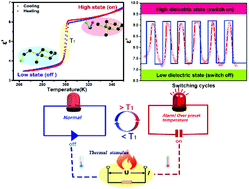A-site cation with high vibrational motion in ABX3 perovskite effectively induces dielectric phase transition†
Abstract
Organic–inorganic hybrid ABX3 perovskite (OIHPs) with phase transition have considerable application potential in multifunctional devices for their structural tunability and excellent photo/electric performance. Because the interaction between molecules during the crystallization process is difficult to predict and control, exploring targeted chemical design methods to synthesize phase change materials has been an interesting and challenging problem. As per the synergistic effect of anion and cation, we assemble a cation with high vibrational activity and an inorganic anion with large voids to successfully design a one-dimensional OIHPs phase change material. [FMPD][Cd(SCN)3] (FMPD = 1-fluoroethyl-1-methylpiperidinium) undergoes two reversible phase transitions above room temperature with the substitution of methyl with fluoroethyl increasing the energy barrier of molecular motion. The individual crystal diffraction structures show that, unlike the phase change caused by the reorientation of organic cations in majority of known perovskites, this phase transition is triggered by the order/disorder of cations and anions related to the vibration increase by the introduction of fluoroethyl. The results provide a new design idea for the design and assembly of novel OIHPs-type phase change materials.



 Please wait while we load your content...
Please wait while we load your content...